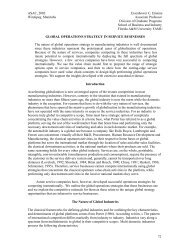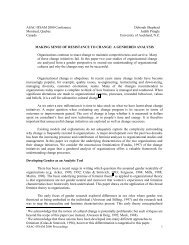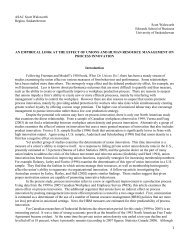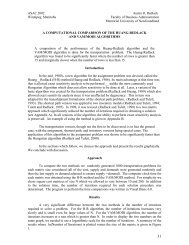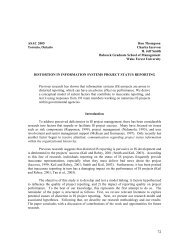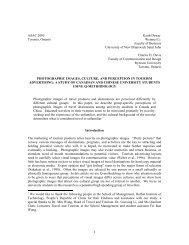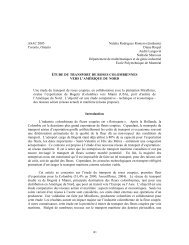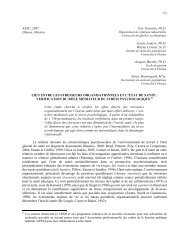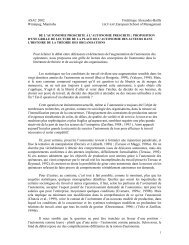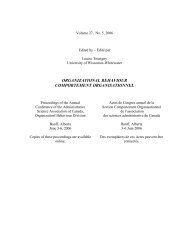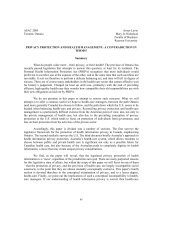ConclusionResearchers of social influence in organizations have recently produced significantadvancements toward the objective of attaining a better understanding of the precise mechanismsand targets of influence that unfold among employees in the work place. Yet most of this workhas been limited to employee perceptions and attitudes (Ibarra & Andrews, 1993; Johanson,2000; Meyer, 1994), which, arguably, are first level outcomes of influence processes (Salancik &Pfeffer, 1978). Notwithstanding the importance of employee perceptions and attitudes, theposition argued in this chapter was that a neglect of how social influence might affect employeebehavior is a shortcoming in the literature because today’s organization needs to find new waysof soliciting employee cooperation that are independent of management rule. Peer socialinfluence is one such means, and its power to affect behavior was evident in the study presented.Peer consultation highlights the contextual nature of role enactment processes in organizations(Meyer, 1994) and represents a key tool of realizing the potential of organizational culture toaffect member performance behavior (Van Maanen & Schein, 1979). In particular, whereinterpersonal exchanges between employees can serve as a basis for role modeling, as well as theemergence of informal cliques or sub-groups can foster cooperative norms, the drain onmanagerial time and effort to help orient new organizational members may be significantlyreduced. However, care needs to be taken in order to maintain a focus in these efforts oncooperation not just with other individuals, but also with the organizational collective (Bolino,1999).ReferencesAshford, S. & Cummings, L.L. (1983), “Feedback as an individual resource: Personal strategiesof creating information.” <strong>Organizational</strong> Behavior and Human Performance, 32: 370-398.Bolino, M.C. (1999), “Citizenship and impression management: Good soldiers or good actors?Academy of Management Review, 24: 82-98.Borgatti, S.P., Everett, M.G., & Freeman, L. (1999), UCINET 5 Version 1.0. Natick, MA:Analytic Technologies.Borman, W.C. & Motowidlo, S.J. (1993), “Expanding the criterion domain to include elements ofcontextual performance,” In N. Schmitt & W.C. Borman (Eds.), Personnel selection inorganizations: 71-98. San Francisco: Jossey-Bass.Burt, R.S. (1976), “Positions in social networks,” Social Forces, 55:93-122.Callero, P.L. (1994), “From role playing to role-using: Understanding role as resource.“ SocialPsychology Quarterly 57: 228-243.Dansereau, F., Graen, G., & Haga, W.J., (1975), “A vertical dyad linkage approach to leadershipwithin formal organizations.” <strong>Organizational</strong> Behavior and Human Performance, 13: 46-78.DiMaggio, P. (1992), “Nadel’s paradox revisited: Relational and cultural aspects oforganizational structure.” In N. Nohria & R. Eccles (eds.), Networks and Organizations:Structure, Form, and Action: 118-142. Boston, MA: Harvard Business School Press.Erickson, B.H. (1988), “The relational basis of attitudes.” In B. Wellman & S.D. Berkowitz(Eds.), Social structures: A network approach: 99-121. Cambridg, UK: CambridgeUniversity Press.Feldman, D.C., (1981), “The multiple socialization of organization members.” Academy ofManagement Review, 6: 309-318.Festinger, L. (1954), “A theory of social comparison processes” Human Relations, 7:114-140.Friedkin, N.A. (1984), “Structural cohesion and equivalence explanations of socialhomogeneity.” Sociological Methods and Research, 12: 235-261.Goffman, E. (1961), Encounters. New York: Boss-Merrill.Hall, D.T. & Moss, J.E. (1998), “The new Protean career contract: Helping organizations andemployees adapt.” <strong>Organizational</strong> Dynamics; 26: 22-37.Ibarra, H. (1992), “Homophily and differential returns: Sex differences in network structure and62
access in an advertising firm.” Administrative Science Quarterly, 37: 422-447.Ibarra, H. & Andrews, S.B. (1993), “Power, social influence, and sense making: Effects ofnetwork centrality and proximity on employee perceptions.” Administrative ScienceQuarterly, 38: 277-303.Johanson, J.-E. (2000), “Intraorganizational influence.” Management Communication Quarterly.13: 393-425.Johns, G. & Saks, A.M. (2001), <strong>Organizational</strong> <strong>Behaviour</strong> (5 th Ed.) Toronto: Addison WesleyLongmanKatz, D. (1964), “The motivational basis of organizational behavior,” Behavioral Science, 9: 131-146.Katz, D. & Kahn, R.L. (1978), The social psychology of organizations. New York: Wiley.Krackhardt, D. (1988), “Predicting with networks: Nonparametric multiple regression analysis ofdyadic data,” Social Networks, 10: 359-381.Krackhardt, D. (1992), “The strength of strong ties: The importance of Philos.” In N. Nohria & R.Eccles (Eds.), Network organizations: Structure, form and action: 216-239. Boston: HarvardUniversity Press.Krackhardt, D. & Porter, L.W. (1986), The snowball effect: turnover embedded incommunication networks. Journal of Applied Psychology, 71: 50-55.Lamertz, K. (2002), “The social construction of fairness: Sense making and social influence inorganizations.” Journal of <strong>Organizational</strong> Behavior, 23: 19-37.Lakoff, G. (1987), Women, fire, and dangerous things: What categories reveal about the mind.Chicago, IL: Chicago University Press.Lincoln, J.R. & Miller, J. (1979), “Work and friendship ties in organizations: A comparativeanalysis of relational networks,” Administrative Science Quarterly, 24: 181-199.Lind, A.L. & Tyler, T.R. (1988), The Social Psychology of Procedural Justice. New York:Plenum Press.Marsden, P.V. (1990), “Network data and measurement,” Annual Review of Sociology, 16: 435-463.Merton, R.K., (1957), “The role-set: Problems in sociological theory.” British Journal ofSociology, 8: 106-120.Meyer, G.W., (1994), “Social information processing and social networks: A test of socialinfluence mechanisms.” Human Relations, 47: 1013-1047.Moorman, R.H. (1991), "Relationship between organizational justice and organizationalcitizenship behaviours: Do fairness perceptions influence employee citizenship?" Journal ofApplied Psychology, 76: 845-855.Morrison, E.W. (1994), “Role definitions and organizational citizenship behavior: Theimportance of the employee's perspective.” Academy of Management Journal, 37: 1543-1567.Morrison, E.W. (2002), “Newcomers’ relationships: the role of social network ties duringsocialization.” Academy of Management Journal, 45: 1149-1160.Niehoff, B.P. & Moorman, R.H. (1993), “Justice as a mediator of the relationship betweenmethods of monitoring and organizational citizenship behavior,” Academy of ManagementJournal; 36: 527-556.Organ, D.W. (1988), <strong>Organizational</strong> citizenship behavior: The good soldier syndrome. LexingtonMA: Lexington Books.Organ, D.W. (1990), "The motivational basis of organization citizenship behaviour," In L.L.Cummings & B.M. Staw (eds.), Research in <strong>Organizational</strong> <strong>Behaviour</strong>, 12: 43-72.Organ, D.W. (1997), “<strong>Organizational</strong> Citizenship Behavior: It’s construct clean-up time” HumanPerformance, 10: 85-97.Pfeffer, J. (1981), "Management as Symbolic Action: The Creation and Maintenance of<strong>Organizational</strong> Paradigms," in L.L. Cummings & B.M. Staw (eds.), Research in<strong>Organizational</strong> Behavior, 3: 1-52.Podsakoff, P.M., MacKenzie, S.B., Paine, J.B., & Bachrach, D.G. (2000), “<strong>Organizational</strong>citizenship behaviors: A critical review of the theoretical and empirical literature and63
- Page 1 and 2:
Volume 24, No. 5, 2003Edited by/Éd
- Page 4 and 5:
Pursey HeugensGreg IrvingRoderick I
- Page 6 and 7:
TABLE OF CONTENTS - TABLE DES MATI
- Page 8 and 9:
study of power displays in mixed-ge
- Page 10 and 11:
on expectations and behaviour (Berg
- Page 12 and 13:
TaskThis study required the use of
- Page 14 and 15:
Task-Gender (male-stereotyped or fe
- Page 16 and 17:
It is important to understand the s
- Page 18 and 19: Crown, C.L. & Cummins, D.A. (1998).
- Page 20 and 21: Smith-Lovin, L., & Brody, C. (1989)
- Page 22 and 23: Table 2Summary of Descriptive Stati
- Page 24 and 25: Table 4Summary of Interaction of Ge
- Page 26 and 27: ASAC 2003Halifax, Nova ScotiaIain L
- Page 28 and 29: the interrelationships among the MB
- Page 30 and 31: studies (Friedman and Sarros, 1989;
- Page 32 and 33: This study demonstrated that emotio
- Page 34 and 35: Anxiety, Stress and Coping, in pres
- Page 36 and 37: Washington, DC: Taylor and Francis,
- Page 38 and 39: Table 2Overall Goodness-of-Fit Indi
- Page 40 and 41: ζ 3Depersonalizationη 3β 3,1 (+)
- Page 42 and 43: ASAC 2003Halifax, Nova ScotiaWendy
- Page 44 and 45: views independently, gave rise to S
- Page 46 and 47: track assistant, associate, and ful
- Page 48 and 49: ole conflict are positively related
- Page 50 and 51: Table 3. Regression of climate and
- Page 52 and 53: interests.We speculate the null eff
- Page 54 and 55: DOOP and short for DOOP scales,”
- Page 56 and 57: Pelled, L. H., “Demographic diver
- Page 58 and 59: esulting increase in discretion ove
- Page 60 and 61: al., 1995). However, the distinctio
- Page 62 and 63: ise to strong pressures for conform
- Page 64 and 65: presented with a complete list of a
- Page 66 and 67: Table 3QAP Regression Coefficients
- Page 70 and 71: suggestions for further research.
- Page 72 and 73: performing on the job.” Presumabl
- Page 74 and 75: positively related to performance i
- Page 76 and 77: proposed hypotheses were supported.
- Page 78 and 79: ConclusionThis research has made se
- Page 80 and 81: Be more enthusiastic and exert extr
- Page 82 and 83: Table 2Correlations Among the Laten
- Page 84 and 85: performance expectations on feedbac
- Page 86 and 87: changements qui s’opèrent dans l
- Page 88 and 89: structures, politiques, systèmes,
- Page 90 and 91: comportements liés à la communica
- Page 92 and 93: Tableau 2Échelles de mesure de la
- Page 94 and 95: prédiction des compétences clés
- Page 96 and 97: organisation n’est pas uniforme e
- Page 98 and 99: complètement ce construit. Ces cha
- Page 100 and 101: Wagner, R.K. and Sternberg, R.J. (1
- Page 102 and 103: What is a toxin handler?In two arti
- Page 104 and 105: potentially limited scope and conte
- Page 106 and 107: work role demands. In this survey,
- Page 108 and 109: The three factors in this rotated f
- Page 110 and 111: and service orientation, the abilit
- Page 112 and 113: ASAC 2003Halifax, Nova ScotiaLisa M
- Page 114 and 115: self-appraisal group reacted more n
- Page 116 and 117: effect of voice are the value-expre
- Page 118 and 119:
“Strongly Disagree” to “Stron
- Page 120 and 121:
esults suggest that incorporating s
- Page 122 and 123:
Personality and Social Psychology,
- Page 124 and 125:
Table 1Means, Standard Deviations,
- Page 126 and 127:
Table 3Test of the Mediating Role o
- Page 128 and 129:
ASAC 2003Halifax, Nova ScotiaAnn Fr
- Page 130 and 131:
individual level, polychronicity is
- Page 132 and 133:
construct.Drawing on computer-media
- Page 134 and 135:
Consequence: Impact on Work Overloa
- Page 136 and 137:
Conversation complexity may also mo
- Page 138:
Implications for practiceFuture res
- Page 141 and 142:
ReferencesAncona, D.G., Goodman, P.
- Page 143 and 144:
no. 3 (1994): 381-391.Macan, T.H.,
- Page 145 and 146:
ASAC 2003Halifax, Nova ScotiaIan R.
- Page 147 and 148:
Assessing Measures: Affective Commi
- Page 149 and 150:
implications of psychological contr
- Page 151 and 152:
commitment, affective commitment, c
- Page 153 and 154:
Motivational Process Variables. Amo
- Page 155 and 156:
DiscussionThe main purpose of this
- Page 157 and 158:
approaches zero. In the present stu
- Page 159 and 160:
Extension and test of a three-compo
- Page 162 and 163:
Table 1Descriptive Statistics and Z
- Page 164 and 165:
Table 3Standardized Factor Loadings
- Page 166 and 167:
Table 5Hierarchical Regression Anal
- Page 168 and 169:
ASAC 2003Halifax, Nova ScotiaJoan F
- Page 170 and 171:
ASAC 2003Halifax, Nova ScotiaArla D
- Page 172 and 173:
ASAC 2003Halifax, Nova ScotiaIvy Ky
- Page 174:
ASAC 2003Halifax, Nova ScotiaNina D



